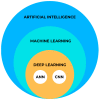AI in Orthodontics: Revolutionizing Diagnostics and Treatment Planning-A Comprehensive Review
- PMID: 38256478
- PMCID: PMC10816993
- DOI: 10.3390/jcm13020344
AI in Orthodontics: Revolutionizing Diagnostics and Treatment Planning-A Comprehensive Review
Abstract
The advent of artificial intelligence (AI) in medicine has transformed various medical specialties, including orthodontics. AI has shown promising results in enhancing the accuracy of diagnoses, treatment planning, and predicting treatment outcomes. Its usage in orthodontic practices worldwide has increased with the availability of various AI applications and tools. This review explores the principles of AI, its applications in orthodontics, and its implementation in clinical practice. A comprehensive literature review was conducted, focusing on AI applications in dental diagnostics, cephalometric evaluation, skeletal age determination, temporomandibular joint (TMJ) evaluation, decision making, and patient telemonitoring. Due to study heterogeneity, no meta-analysis was possible. AI has demonstrated high efficacy in all these areas, but variations in performance and the need for manual supervision suggest caution in clinical settings. The complexity and unpredictability of AI algorithms call for cautious implementation and regular manual validation. Continuous AI learning, proper governance, and addressing privacy and ethical concerns are crucial for successful integration into orthodontic practice.
Keywords: CBCT; artificial intelligence; cephalometric analysis; deep learning; orthodontics; radiology; skeletal age; treatment planning.
Conflict of interest statement
The authors declare no conflicts of interest.
Figures



References
-
- McCarthy J., Minsky M.L., Rochester N., Shannon C.E. A Proposal for the Dartmouth Summer Research Project on Artificial Intelligence. AI Mag. 2006;27:12.
-
- Haenlein M., Kaplan A. A Brief History of Artificial Intelligence: On the Past, Present, and Future of Artificial Intelligence. Calif. Manag. Rev. 2019;61:5–14. doi: 10.1177/0008125619864925. - DOI
-
- Gulshan V., Peng L., Coram M., Stumpe M.C., Wu D., Narayanaswamy A., Venugopalan S., Widner K., Madams T., Cuadros J., et al. Development and Validation of a Deep Learning Algorithm for Detection of Diabetic Retinopathy in Retinal Fundus Photographs. JAMA. 2016;316:2402–2410. doi: 10.1001/jama.2016.17216. - DOI - PubMed
Publication types
LinkOut - more resources
Full Text Sources
Miscellaneous

